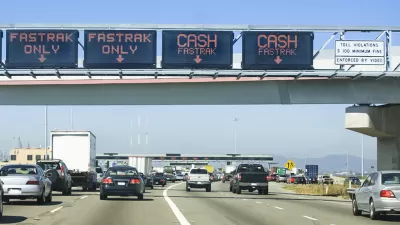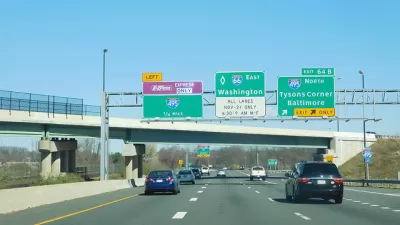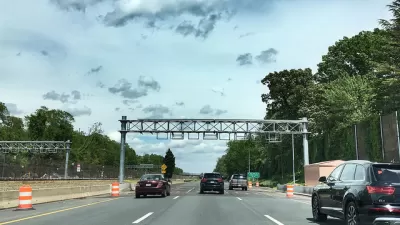Two things motorists detest: tolls and congestion. Tolls, if effectively applied, lessen congestion, but at a high cost to drivers. However, steep tolls also provide a political incentive to "fix the bottlenecks," as shown by the 66 Express Lanes.

Another lesson from what may be America's best example of roadway congestion pricing, where tolls topping $40 (one-way) do occur on occasion, particularly when the subway breaks down.
Max Smith, WTOP’s Northern Virginia transportation reporter, writes that construction has begun to add an additional lane "to ease a chokepoint that helps drive up toll prices on Interstate 66 inside the Capital Beltway...Those frequent traffic jams are a significant driver of the morning toll prices for solo drivers using the highway."
Unlike all other high occupancy tolls (HOT) lanes adjacent to general purpose (unpriced) lanes in the United States, all lanes on the 66 Express Lanes become HOT lanes during the peak hours in the peak direction, so motorists can't escape the congestion, nor the toll unless they carpool ride a motorcycle.
The operator of the 66 Express Lanes, the Virginia Department of Transportation (VDOT), may also be more politically sensitive to criticism than private operators, such as Transurban, an Australian company which built and operates the 495 and 95 Express Lanes in Virginia. VDOT has been attempting to reduce the tolls, without capping or refunding them, as some legislators demand, by tweaking the toll pricing algorithm.
Average tolls on 66 Express Lanes
While those $40+ tolls make headlines, they are not the norm. Smith reported on Aug. 20 that "[f]rom the time tolling began Dec. 4 through the end of June, the overall average paid by each toll payer each morning is now $8.39, with the average in the afternoon now at $5.21."
Tolls are higher in the morning than the afternoon largely due to the chokepoint at the Dulles Connector Road, where traffic can frequently slow...
Which brings us back to where we started, as this is the stretch that's being widened.
Smith also reported that the violation rate, i.e., motorists who don't have transponders (E-ZPass) and face penalties on top of tolls, is 13.5 percent.
While the 66 Express Lanes are unique due to the all-HOT Lane design, they are similar to other HOT lanes in that a large percentage of users are not paying tolls because these are, after all, carpool lanes. Unlike other HOT lanes, there is no toll-exemption for electric vehicles.
Overall, more vehicles paid to use the road in June with a regular E-ZPass or an E-ZPass Flex in toll paying mode (44.2 percent) than rode free with an E-ZPass Flex switched to HOV mode to indicate the driver had at least one other person with them in the car (42.3 percent).
Related 66 Express Lanes posts:
-
Capitalism at Work on an Interstate Highway, June 12, 2018
-
Popularity of Express Lanes Spreads Beyond Virginia, April 3, 2018
Hat tip to IBTTA Smart Brief.
FULL STORY: I-66 widening work on choke point that drives up tolls begins

Trump Administration Could Effectively End Housing Voucher Program
Federal officials are eyeing major cuts to the Section 8 program that helps millions of low-income households pay rent.

Planetizen Federal Action Tracker
A weekly monitor of how Trump’s orders and actions are impacting planners and planning in America.

Ken Jennings Launches Transit Web Series
The Jeopardy champ wants you to ride public transit.

Crime Continues to Drop on Philly, San Francisco Transit Systems
SEPTA and BART both saw significant declines in violent crime in the first quarter of 2025.

How South LA Green Spaces Power Community Health and Hope
Green spaces like South L.A. Wetlands Park are helping South Los Angeles residents promote healthy lifestyles, build community, and advocate for improvements that reflect local needs in historically underserved neighborhoods.

Sacramento Plans ‘Quick-Build’ Road Safety Projects
The city wants to accelerate small-scale safety improvements that use low-cost equipment to make an impact at dangerous intersections.
Urban Design for Planners 1: Software Tools
This six-course series explores essential urban design concepts using open source software and equips planners with the tools they need to participate fully in the urban design process.
Planning for Universal Design
Learn the tools for implementing Universal Design in planning regulations.
Heyer Gruel & Associates PA
Ada County Highway District
Institute for Housing and Urban Development Studies (IHS)
City of Grandview
Harvard GSD Executive Education
Toledo-Lucas County Plan Commissions
Salt Lake City
NYU Wagner Graduate School of Public Service




























